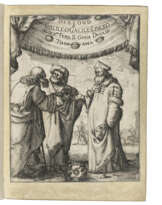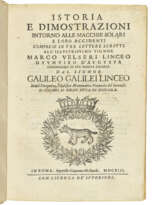ID 794565
Lot 157 | [GALILEI, Galileo (1564-1642)] — CASTELLI, Benedetto
Estimate value
£ 8 000 – 12 000
Risposta alle opposizioni del S. Lodovico delle Colombe, e des S. Vincenzio di Grazia, contro al trattato del Sig. Galileo Galilei, delle cose che stanno su l'acqua o che in quella si muouono ... Nella quale si contengono molte considerazioni filosofiche remote dalle vulgate opinioni. Florence: Cosimo Giunti, 1615.
First edition of Galileo's principal text on the controversy over floating bodies from the scientific collection of the Riccati family. Like several of his polemics of his period, it appeared under the name of a colleague, in this case his pupil and friend Castelli. This work was written as a reply to two attacks by Colombe and Grazia on Galileo's 1612 treatises on floating bodies. 'Using the concept of moment and the principle of virtual velocities, Galileo extended the scope of the Archimedean work beyond purely hydrostatic considerations'’ (DSB). Galileo's position involved philosophic principles, and was regarded as a challenge to the authority of Aristotle. In the present reply to his academic critics, he enlarged both the scientific reasoning behind his position and presented a vigorous philosophical defence of that position. In the second replying to Grazia, Galileo states that he made use of two basic principles, 'that equal weights moved with equal speed are of like power in their effects, and that greater heaviness of one body could be offset by greater speed of another' (Stillman Drake). This copy contains the rare two additional leaves (Y2) completing the errata and giving the registration and printer's device, not recorded by Cinti. From the Riccati collection, whose most prominent bibliophile members were Jacopo Francesco Riccati (1676-1754) and his son Vincenzo (1707-75), both mathematicians and physicists, Carli and Favaro 66; Cinti 51; Riccardi I, 289.
Quarto (217 x 153mm). Woodcut printer's device on title, large device on verso of final leaf, historiated initials (occasional light spotting and dampstaining, some browning, tiny marginal hole in title). 18th-century marbled leather, flat spine gilt, red and black spine labels (minor worming) Provenance: Riccati collection (armorial bookplate).
Special notice
No VAT on hammer price or buyer's premium.
| Artist: | Galileo Galilei (1564 - 1642) |
|---|---|
| Place of origin: | Italy, Europe |
| Auction house category: | Printed books |
| Artist: | Galileo Galilei (1564 - 1642) |
|---|---|
| Place of origin: | Italy, Europe |
| Auction house category: | Printed books |
| Address of auction |
CHRISTIE'S 8 King Street, St. James's SW1Y 6QT London United Kingdom | |
|---|---|---|
| Preview |
| |
| Phone | +44 (0)20 7839 9060 | |
| Buyer Premium | see on Website | |
| Conditions of purchase | Conditions of purchase |
![[GALILEI, Galileo (1564-1642)] — CASTELLI, Benedetto - photo 1 [GALILEI, Galileo (1564-1642)] — CASTELLI, Benedetto - photo 1](/assets/image/picture_2279448/7fcd8/0c6646dd107660ed4adadc32f328199d1657663200jpg__fix_555_460.jpeg)
![[GALILEI, Galileo (1564-1642)] — CASTELLI, Benedetto - photo 2 [GALILEI, Galileo (1564-1642)] — CASTELLI, Benedetto - photo 2](/assets/image/picture_2279449/cc79f/175f4d9a200682d84be2fbad64cd4f441657663200jpg__fix_555_460.jpeg)
![[GALILEI, Galileo (1564-1642)] — CASTELLI, Benedetto - photo 3 [GALILEI, Galileo (1564-1642)] — CASTELLI, Benedetto - photo 3](/assets/image/picture_2279450/bf344/1afebaae7abdd61ad6a0994d826663c31657663200jpg__fix_555_460.jpeg)






![[GALILEO GALILEI (1564-1642) and Girolamo SPINELLI (c.1580-1647)]](/assets/image/picture_4734998/81ecb/b78ba02793ea9f7c89bc2421c803edfc1752012000jpg__fix_162_205.jpeg)


![[GALILEI, Galileo (1564-1642)] — CASTELLI, Benedetto - photo 1 [GALILEI, Galileo (1564-1642)] — CASTELLI, Benedetto - photo 1](/cache/lot/794565/0c6646dd107660ed4adadc32f328199d_1657663200-80x80_center_50.jpg)
